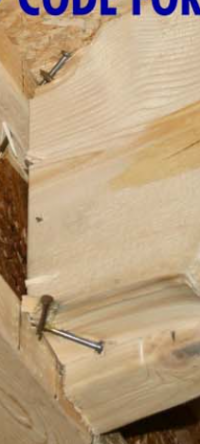-
Welcome to The Building Code Forum
Your premier resource for building code knowledge.
This forum remains free to the public thanks to the generous support of our Sawhorse Members and Corporate Sponsors. Their contributions help keep this community thriving and accessible.
Want enhanced access to expert discussions and exclusive features? Learn more about the benefits here.
Ready to upgrade? Log in and upgrade now.
You are using an out of date browser. It may not display this or other websites correctly.
You should upgrade or use an alternative browser.
You should upgrade or use an alternative browser.
Another Failed Inspection Passed by Inspector
- Thread starter jar546
- Start date
fatboy
Administrator
Not knocking sparky's and plumbers, but this is what happens when you let "combo" inspectors loose. Often, then don't understand or give a hoot about structural issues. I had a couple in my days.
Msradell
SAWHORSE
What can/do you do in a case like this?
Any time a sentence starts with "not knocking" you know that's exactly what's coming. As to letting me loose ... well then open the cage and stand back.Not knocking sparky's and plumbers, but this is what happens when you let "combo" inspectors loose. Often, then don't understand or give a hoot about structural issues. I had a couple in my days.
jar546
CBO
I thought we already had a very contentious thread on this very subject. I will try to find it and see if it will come back from the depths so we don't get too far off into thread drift land.Any time a sentence starts with "not knocking" you know that's exactly what's coming. As to letting me loose ... well then open the cage and stand back.
Do you use bumpers when bowling? You're getting to be a pain in the ass.
jar546
CBO
Do you use bumpers when bowling? You're getting to be a pain in the ass.
The Pitfalls of Multi-Discipline Inspectors
I am rather confident that I will rattle some cages but I honestly have to open up and be honest with my opinion on this, especially as a multi-discipline inspector with 17 certifications. First of all, I am going to clarify something. In my opinion, this does not apply to residential only and...
www.thebuildingcodeforum.com
So what! I was replying to the fat guy. You know Google narrows down what we get to see because Google thinks that Google knows best. If everything is sterilized for us, we don't see what we didn't expect... we don't expand our horizons. It get bland.
If you don't want anything other than what you want you should post locked threads.
If you don't want anything other than what you want you should post locked threads.
Sifu
SAWHORSE
- Joined
- Sep 3, 2011
- Messages
- 3,440
In conjunction with the other most recent post about clarifying the various terms for non-AHJ inspectors/agencies, you say this was approved by a third party agency inspector. Is that the case? Perfect example of the need for some sort of oversight, or peer review, no matter how the person is employed.
This may drift a little, so if you want to keep this thread on point, I get it. I am curious about your role, not being critical, but a little envious (what fun one could have!) Are you acting as a consultant to the owner, with no duties other than to provide them an opinion that they can use in whatever means they see fit? Do they then present items from your list to the builder? The inspection department? Is this an area outside of the one in which you carry legal enforcement responsibilities? Do they reference you in their presentation of any deficiencies? Are their licensing requirements to act in this capacity, such as a licensed home inspector? Do you carry insurance to operate in this capacity?
As a former licensed home inspector, in another time and place, I did construction inspections occasionally, and since then (not carrying any licensing or insurance) I have been asked to do this by private owners and realtors occasionally. I usually decline, or do it for free because I am not sure if there are any legal ramifications. I tell them I am presenting opinions based on education and experience, that nobody is under any responsibility to pay any attention to.
The photo is some very low hanging fruit, not something it would take anyone any time or training to find, but in general, I would expect you might hear some derision if/when your findings are presented to the building department. I expect there would be some excuses about the amount of time and attention you give a project vs. what an inspector has time to do. In the case of this photo, what is the reaction by the various entities when this was pointed out?
This may drift a little, so if you want to keep this thread on point, I get it. I am curious about your role, not being critical, but a little envious (what fun one could have!) Are you acting as a consultant to the owner, with no duties other than to provide them an opinion that they can use in whatever means they see fit? Do they then present items from your list to the builder? The inspection department? Is this an area outside of the one in which you carry legal enforcement responsibilities? Do they reference you in their presentation of any deficiencies? Are their licensing requirements to act in this capacity, such as a licensed home inspector? Do you carry insurance to operate in this capacity?
As a former licensed home inspector, in another time and place, I did construction inspections occasionally, and since then (not carrying any licensing or insurance) I have been asked to do this by private owners and realtors occasionally. I usually decline, or do it for free because I am not sure if there are any legal ramifications. I tell them I am presenting opinions based on education and experience, that nobody is under any responsibility to pay any attention to.
The photo is some very low hanging fruit, not something it would take anyone any time or training to find, but in general, I would expect you might hear some derision if/when your findings are presented to the building department. I expect there would be some excuses about the amount of time and attention you give a project vs. what an inspector has time to do. In the case of this photo, what is the reaction by the various entities when this was pointed out?
mtlogcabin
SAWHORSE
Never nail into the side of an I-joist flange as it may split the flange depending on what it is made of, Laminated material or dimensional lumber.Not sure I see a problem. Three or four nails seem pretty strong
Bottom flanges like the bottom cord of a truss are very limited in what PSF they can support.
Notice the split and the missing chunks of wood at the top and bottom where the nails are.

Sarcasm my friend, sarcasm.Never nail into the side of an I-joist flange as it may split the flange depending on what it is made of, Laminated material or dimensional lumber.
Bottom flanges like the bottom cord of a truss are very limited in what PSF they can support.
Notice the split and the missing chunks of wood at the top and bottom where the nails are.
View attachment 12693
mtlogcabin
SAWHORSE
Sometimes I just do not recognize what I am told I do a lot.
My apologies I should have realized that.
My apologies I should have realized that.
jar546
CBO
In this case, I was hired privately by an owner to perform inspections parallel to the building department. The owner then presents my findings to the builder to make corrections. If the builder is resistant then we have two options to choose from, both at the same time. First, the owner does not release the check to the builder for the phase they are requesting and secondly, if the builder continues to resist, we then turn this over the the building official and if that does not work we then file a complaint with the state against the building inspector and/or official. It rarely has to go that far but we have done it with instant results.Are you acting as a consultant to the owner, with no duties other than to provide them an opinion that they can use in whatever means they see fit? Do they then present items from your list to the builder? The inspection department?

